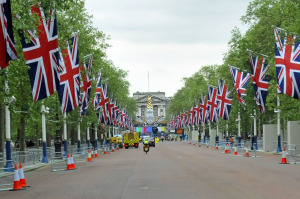Before Londoners longed for a parade street, they had played a lawn game called “pall mall” or simply “mall” on a grassy alley running east from Buckingham Palace. When the game lost popularity in the eighteenth century, the alley became a tree-lined walkway called “the Mall,” pronounced like the first syllable in “mallet.” The Mall proved to be the ideal location for a parade route. So, in 1911, architect Sir Aston Webb remodeled the east façade of Buckingham Palace to be more attractive and erected a statue memorializing Queen Victoria on the palace grounds to anchor a broad new street named “the Mall.”
A proper parade street requires an anchor on both ends. After all, the Champs-Élysées connects the Louvre and the Arc de Triomphe and Pennsylvania Avenue connects the Capitol and the White House. To provide the Mall an eastern anchor, Webb designed the Admiralty Arch straddling the Mall, with three wide archways allowing access to Trafalgar Square just beyond. Befitting a monument honoring seafarers, the Admiralty Arch, completed in 1912, was located exactly .5 nautical miles (.58 statute miles) from the Queen Victoria Memorial.
During ceremonial occasions, rows of Union Jacks flank the Mall from Buckingham Palace to the Admiralty Arch. In the 1950s, iron oxide particles were added to the Mall’s pavement to suggest a red carpet rolled out from Buckingham Palace. The Mall is closed to traffic on Sundays, holidays and ceremonial occasions. As time passed, “mall” came first to mean an area free of automobiles and then, pronounced like the first syllable in “wallet,” a North American shopping center.
In 2011, the English government sold the Admiralty Arch to developers, who are converting it into a five-star hotel. For the next coronation or royal wedding, a west-facing room in the 100-room hotel should be the hottest ticket in town.

Comments are closed.